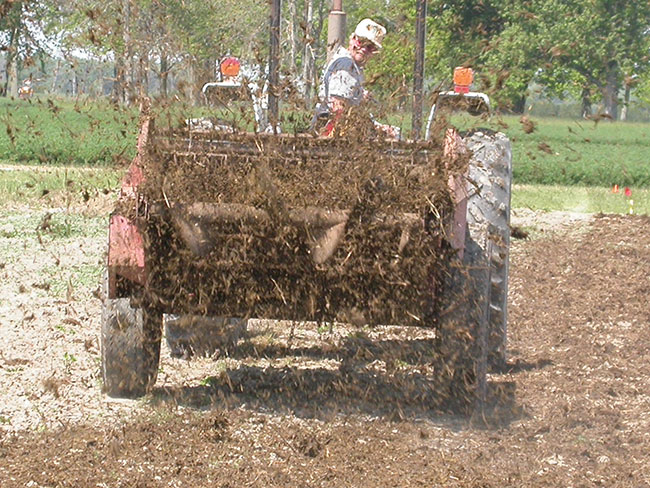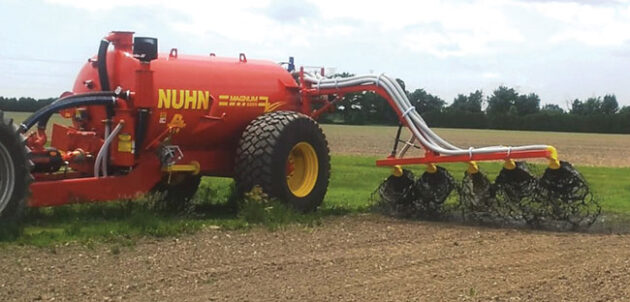
Features
Fertility and Nutrients
Developing 4R practices for manured cropping systems
Adjusting chemical fertilizer rates for differences in nutrient availability in manure-amended soils.
December 5, 2023 By Carolyn King
 Zhang’s project includes field experiments with different manure options, including liquid manure (shown here).
Photos courtesy of Tiequan Zhang, AAFC.
Zhang’s project includes field experiments with different manure options, including liquid manure (shown here).
Photos courtesy of Tiequan Zhang, AAFC. The 4R nutrient management system – using the right nutrient source at the right rate, right time, and right place to meet the crop’s needs – is well known as a system to help increase farm profitability, reduce the risk of environmental impacts, and improve sustainability.
However, Ontario’s 4R recommendations were developed for cropping systems in which only chemical fertilizers are used. What about 4R practices for fertilizers applied to manured cropping systems?
Tiequan Zhang is leading a five-year project to fill that important information gap.
A look at the issues
“There were several reasons why we were thinking about the need to develop 4R for chemical fertilizer applications for manure-amended cropping systems,” says Zhang, a senior research scientist focusing on soil fertility and environmental quality with Agriculture and Agri-Food Canada (AAFC) in Harrow, Ont.
“We have had two long-term manure field studies that have been conducted for 14 or 18 years, respectively, in southwestern Ontario. The results of these two studies have shown that soil organic carbon or organic matter builds up with time in various ways depending on the manure type, form and rate applied.”
The findings also indicated that this organic matter build-up from manure could have important effects on the availability of both nitrogen and phosphorus to crops.
He explains that the breakdown, or mineralization, of organic nitrogen from manure organic matter makes nitrogen available to crops. However, not all of the organic nitrogen is released during the year of manure application. As the remaining nitrogen is released over the years following application, it can have a legacy effect of increased nitrogen availability.
Zhang says, “This released nitrogen can either be used by crops or lost to the environment, such as into the air as greenhouse gases or into the water [which can harm water quality].”
Regarding phosphorus, he explains that manure not only adds phosphorus to the soil but also changes the soil chemistry in a way that reduces the capacity of the soil to fix phosphorus. Both of those factors increase phosphorus availability, which means phosphorus can build up very quickly in manured soils.
If the extra phosphorus is not used by crops, it can be lost to nearby water bodies through surface runoff and/or tile drainage, degrading water quality. Zhang notes that phosphorus loads from agricultural land in southwestern Ontario are a major cause of excessive phosphorus levels in Lake Erie, which can result in toxic algae blooms.
“Because the current Ontario fertilizer recommendations were developed based on chemical fertilizer application only, those recommendations do not consider the legacy aspect of nitrogen from manures and the enhanced availability of phosphorus, which are unique to manured soils,” Zhang explains.
“With manure applications, you are improving soil health, soil aggregate stability, aeration, water-holding capacity and temperature. This consequently enhances the availability of both soil nitrogen and phosphorus to crops.”
As a result of these different factors, using the current 4R recommendations when applying chemical fertilizers to manure-amended soils could lead to applications in excess of the crop’s needs. And that would be a waste of costly chemical fertilizer inputs, increase the risk of nutrient losses to the environment, and reduce farm profitability.
In addition, Zhang explains that the current Ontario fertilizer recommendations do not consider the effects of soil texture on manure nitrogen availability, which could affect whether the crop’s nitrogen supply is too low, just right, or too high.
“Soil texture influences factors like soil moisture content, heat, aeration and microbial activities, which all affect the breakdown of organic matter compounds, nitrogen availability, and the risk of nitrogen losses to the environment.” For instance, sandy soils may have more nitrogen released from organic matter breakdown, but also more nitrogen lost from the soil due to leaching. Clay soils may lose more nitrogen to the air through denitrification.
Zhang notes, “These organic matter and soil texture effects on the availability of nitrogen and phosphorus have not been investigated very much in the past in Ontario fields.”
About the project
The overall goal of Zhang’s project is to develop 4R-based recommendations and identify optimum chemical fertilizer application rates in manure-amended cropping systems in Ontario. The project uses an ecosystem approach that considers the effects on cropping productivity and the environment.
To achieve that goal, Zhang and his research team are working on several objectives that will enable them to flesh out the detailed specifics of nitrogen and phosphorus availability in these manured cropping systems.
One objective is to determine manure nitrogen availability from various manure types and forms in the year of manure application and in the years after application, in soils with different textures. The second objective is to determine phosphorus availability from various manure types and forms in the application year and over the longer term. And the third objective is to investigate the interactions between manure and chemical fertilizers to see how those interactions relate to crop uptake, nutrient-use efficiency and yields, and to soil health.
“In our project, we are using a corn-soybean rotation as the cropping system. This crop combination is very typical not only in southwestern Ontario but also province-wide. We are using both greenhouse studies and field studies,” he says.
“For the greenhouse studies, we use soils collected from farmers’ fields which have been manured or non-manured on a long-term basis, and also soils with different textures.”
The field sites are long-term corn-soybean plots with a range of nutrient application histories. They are located in southwestern Ontario and have different soil textures.
The greenhouse studies and especially the field studies include a broad range of treatments. “We have different types of manure – cattle and pig – and different forms of manure – liquid and solid. And we have combinations of chemical fertilizers with manures in various ratios.”
Across the different treatments, they are analyzing data on many different factors, such as crop yield, nutrient uptake and removal, and nutrient-use efficiency. They are also tracking changes in such soil properties as soil organic carbon, soil mineral nitrogen and soil test phosphorus. And they are monitoring nitrogen and phosphorus losses to water so they can evaluate the impact on water quality.
Based on the results of these studies, they’ll develop optimal chemical fertilizer 4R recommendations that take into account the manure type, form and rate, the soil texture, and the ratio of manure to chemical fertilizer.

His project also compares soil manure options, shown here.
Interesting preliminary observations
Zhang’s project started in 2022 and runs until 2027, so it is still in its early stages. However, he notes, “Since we are using long-term sites that means we can use some data collected from the previous years or from last year to tell some preliminary stories.”
First of all, he sees a number of interesting patterns in the phosphorus data. One is that the availability of soil test phosphorus (an index to indicate the amount of soil phosphorus available to crops) in manured soils can be up to three or four times higher than in soils with only chemical fertilizer applications, depending on the manure type and form and the application approach (nitrogen-based or phosphorus-based).
Specifically, soil phosphorus looks to be more available in soils amended with pig manure than with cattle manure, and in soils amended with solid manure than with liquid manure. Also, phosphorus seems to be more available in soils amended using the traditional nitrogen-based manure application approach than using the newly recommended phosphorus-based application approach.
“Secondly, building on the results from last year’s field study, it seems that the application of animal manure alone or in combination with chemical fertilizer phosphorus enhances soil phosphorus availability for crop production. This is a preliminary confirmation of our hypothesis that organic matter from animal manures changes the soil phosphorus chemistry and may improve the availability to the crops,” he says.
“So that tells us that we do need to improve or develop the 4R fertilizer management practices for crop production systems that previously or currently receive manures.”
Optimizing nutrient management
Zhang explains that the results from this study could help Ontario farmers to make optimal use of both chemical fertilizers and manure resources, resulting in significant economic and ecological benefits.
In particular, the 4R recommendations for chemical fertilizer use in manure-amended cropping systems could help farmers to reduce their fertilizer inputs, better match their nutrient applications to the crop’s needs, and maintain or even improve crop yields.
The recommendations would also help farmers avoid overapplication of fertilizers and manures, thereby reducing the risk of nutrient losses to the environment. In particular, the recommendations could help farmers decrease phosphorus loads to water bodies such as Lake Erie, which are a serious environmental concern.
“With this project, we should be able to develop knowledge and technology that enable us to minimize phosphorus loads by optimizing the nutrient supply with improved use efficiency not only from manures but also from chemical fertilizers and the nutrients from the soils themselves,” he says.
The data from the project could also be used by policymakers to make science/evidence-based regulations for nutrient management and could help agronomists in developing science-based guidelines and decision tools for nutrient management so farmers can make better use of both manure and fertilizer resources.
The 4R manure-related recommendations might also encourage more crop growers to make use of local manure resources rather than relying solely on chemical fertilizers. This addition of manure organic matter to their cropping systems would improve their soil’s physical, chemical and biological health while decreasing their need for chemical fertilizer inputs.
Overall, Zhang thinks the project’s results have the potential to improve farm profitability, enhance environmental health, and increase the sustainability of agricultural production in Ontario. And that could increase the competitiveness of Ontario farm production in the long term.
“I’m really proud of this project, and I really appreciate the support of the industries who have recognized the importance of research on this topic,” he says. The project is funded by Grain Farmers of Ontario, Ontario Pork, A&L Canada Laboratories Limited, and AAFC.